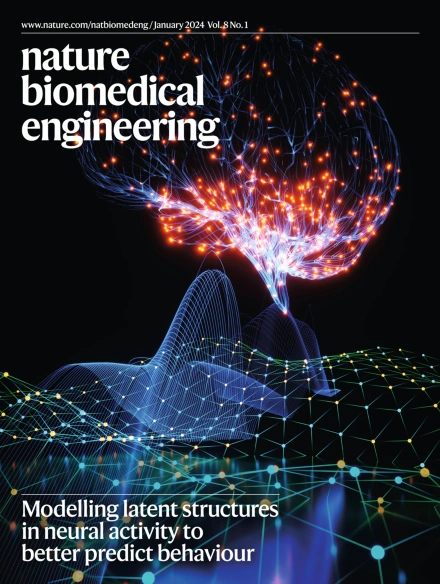An immune-competent lung-on-a-chip for modelling the human severe influenza infection response.
IF 26.8
1区 医学
Q1 ENGINEERING, BIOMEDICAL
引用次数: 0
Abstract
Severe influenza affects 3-5 million people worldwide each year, resulting in more than 300,000 deaths annually. However, standard-of-care antiviral therapeutics have limited effectiveness in these patients. Current preclinical models of severe influenza fail to accurately recapitulate the human immune response to severe viral infection. Here we develop an immune-competent, microvascularized, human lung-on-a-chip device to model the small airways, successfully demonstrating the cytokine storm, immune cell activation, epithelial cell damage, and other cellular- and tissue-level human immune responses to severe H1N1 infection. We find that interleukin-1β and tumour necrosis factor-α play opposing roles in the initiation and regulation of the cytokine storm associated with severe influenza. Furthermore, we discover the critical stromal-immune CXCL12-CXCR4 interaction and its role in immune response to infection. Our results underscore the importance of stromal cells and immune cells in microphysiological models of severe lung disease, describing a scalable model for severe influenza research. We expect the immune-competent human lung-on-a-chip device to enable critical discoveries in respiratory host-pathogen interactions, therapeutic side effects, vaccine potency evaluation, and crosstalk between systemic and mucosal immunity in human lung.用于模拟人类严重流感感染反应的具有免疫能力的肺芯片。
严重流感每年影响全世界300 - 500万人,每年造成30多万人死亡。然而,标准的抗病毒治疗对这些患者的疗效有限。目前严重流感的临床前模型不能准确地概括人类对严重病毒感染的免疫反应。在这里,我们开发了一种免疫能力强、微血管化的人肺芯片设备来模拟小气道,成功地展示了细胞因子风暴、免疫细胞激活、上皮细胞损伤和其他细胞和组织水平的人对严重H1N1感染的免疫反应。我们发现白细胞介素-1β和肿瘤坏死因子-α在与严重流感相关的细胞因子风暴的启动和调节中发挥相反的作用。此外,我们发现了关键的基质免疫CXCL12-CXCR4相互作用及其在感染免疫应答中的作用。我们的研究结果强调了基质细胞和免疫细胞在严重肺部疾病微生理模型中的重要性,为严重流感研究描述了一个可扩展的模型。我们期望这种具有免疫能力的人肺芯片设备能够在呼吸道宿主-病原体相互作用、治疗副作用、疫苗效力评估以及人肺全身免疫和粘膜免疫之间的串音方面取得重大发现。
本文章由计算机程序翻译,如有差异,请以英文原文为准。
求助全文
约1分钟内获得全文
求助全文
来源期刊

Nature Biomedical Engineering
Medicine-Medicine (miscellaneous)
CiteScore
45.30
自引率
1.10%
发文量
138
期刊介绍:
Nature Biomedical Engineering is an online-only monthly journal that was launched in January 2017. It aims to publish original research, reviews, and commentary focusing on applied biomedicine and health technology. The journal targets a diverse audience, including life scientists who are involved in developing experimental or computational systems and methods to enhance our understanding of human physiology. It also covers biomedical researchers and engineers who are engaged in designing or optimizing therapies, assays, devices, or procedures for diagnosing or treating diseases. Additionally, clinicians, who make use of research outputs to evaluate patient health or administer therapy in various clinical settings and healthcare contexts, are also part of the target audience.
 求助内容:
求助内容: 应助结果提醒方式:
应助结果提醒方式:


